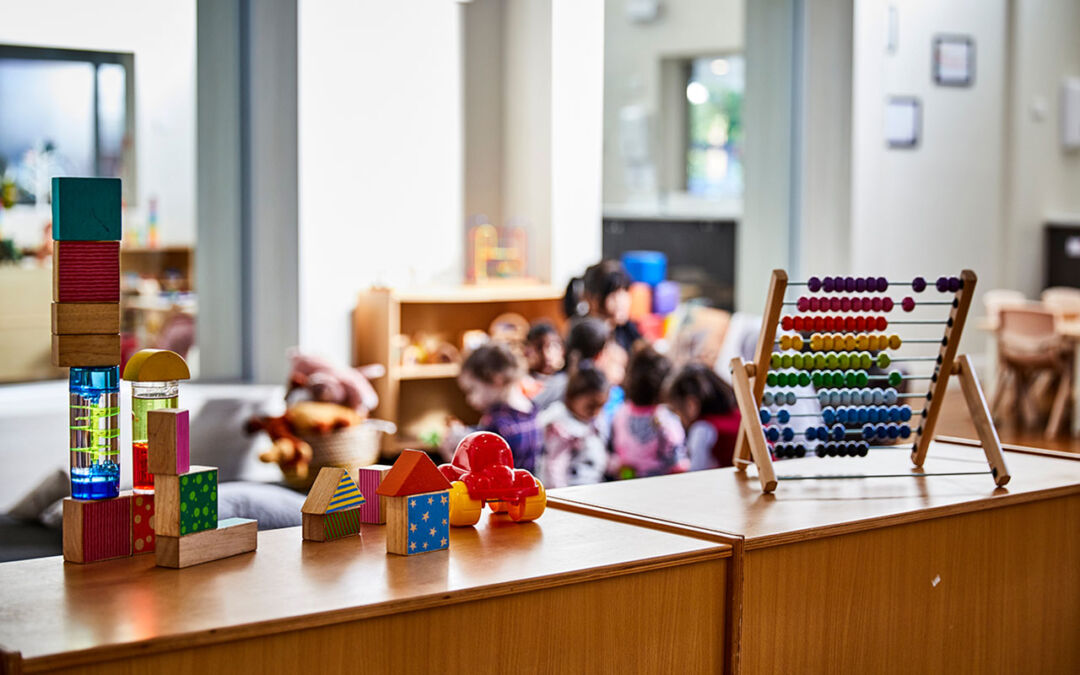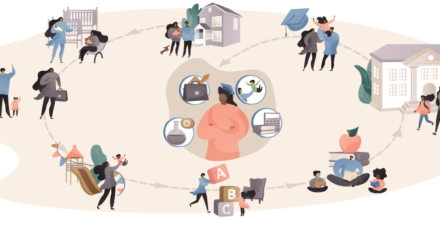Advancing research and evidence on child care and U.S. economic growth

Research shows that accessible and affordable child care is both a lifeline for working families and a driver of growth across the entire U.S. economy. A functioning child care market has the potential to grow the economy through several distinct channels: assisting parents who choose to pursue work, helping children grow and develop their human capital, and providing high-quality jobs for caretakers.
These mechanisms of growth have been discussed by scholars for decades, but further research would help policymakers establish and fine-tune a functioning child care system in the United States that maximizes the potential for economic growth. With that in mind, Equitable Growth recently convened more than 30 economists, social scientists, policymakers, and advocates to discuss research questions and needs that could further shed light on the important role that child care plays in propping up the overall economy, as well as policy strategies that could help shore up the U.S. child care industry.
This meeting was part of Equitable Growth’s Child Care Research Accelerator initiative, which furthers our commitment to advancing research and evidence that supports broad-based and sustainable economic growth. In addition to serving as an important discussion forum, the convening uncovered new opportunities for research, which has helped to inform the funding strategy for Equitable Growth’s 2023 Request for Proposals.
This column summarizes some of the research questions and themes discussed at this convening, and then outlines Equitable Growth’s research priorities around child care and early education going into our 2023 grantmaking cycle.
The gaps in research on child care and U.S. economic growth
Researchers at Equitable Growth’s recent child care convening raised several different areas where further research on child care and early education would be valuable. These research questions focus on the foundational relationship between early care and education and the economy, sectors of the child care market that have been underinvestigated in prior research, and new research opportunities offered by policy change. Below, we look at these topics in more detail.
Updating estimates of the labor market impacts of child care price changes
One underling theme of recent research on the potential impact of increasing public investments in child care on economic activity are estimates of parents’ elasticity to employment to child care prices. In other words, how much more or less will parents work if child care prices increase or decrease?
In her review of the literature, Taryn Morrissey of American University reports that a 10 percent reduction in child care prices increases parental employment approximately 0.5 percent to 2.5 percent, indicating an elasticity of 0.05–0.25. Importantly, Morrissey notes, these estimates are smaller when using more recent data and data from international sources, suggesting that parents’ elasticity to employment is neither static nor homogenous.
A theme that emerged at the convening was that precise and current elasticity estimates are crucial to ensuring that policymakers have an accurate understanding of the economic impact of various early care and early education proposals. Economic models that rely on inaccurate or outdated elastic estimates have the potential to dramatically underestimate or overestimate changes in labor force participation resulting from child care investments.
Updating these price elasticity estimates should be a priority among researchers studying child care and early education in the U.S. economy. In addition, as parents tend to make employment decisions based on their preferences for child care type, quality, and geographic location, among other factors, as well as pure prices, future research also should aim to shed light on how these other factors impact employment decisions in relation to price elasticity.
Exploring the practices and experiences of home-based, underground, or less-identifiable care arrangements
A functioning child care market is one that offers a diverse range of care options to best meet the range of needs that arises in a given community. Research on families’ child care decisions reinforces the importance of care received outside of traditional child care centers. Yet researchers and policymakers alike have directed more of their focus toward these larger centers, while less is known about the size and economic impact of the home- and family-care markets.
Convening participants suggested this is largely an issue of identifiability and data access, rather than a failure to recognize the importance of noncenter providers. Many home- and family-based providers exist outside of the formal child care market, and public data on these provider types are limited. Future child care research should work to fill some of these gaps in the data on nontraditional child care options.
Several participants also advocated for research on U.S. military child care options. The U.S. military operates and funds a large and dispersed child care market for military families. While these facilities have generally been considered high quality, long waitlists have prompted recent efforts to expand the military’s child care infrastructure and community-based options. This unique child care market may be ripe for future research on government-provided child care.
Evaluating how the U.S. child care market responds to economic and policy change
Similar to nearly all sectors of the U.S. economy, child care does not exist in a vacuum immune from economic and policy change. Indeed, prior research from Chris M. Herbst at Arizona State University and Jessica H. Brown at the University of South Carolina describes child care’s asymmetrical exposure to macroeconomic trends. In other words, they find that in economic downturns, employment in the child care sector declines slightly faster than employment across the broader U.S. labor force, while child care job growth is significantly slower than other sectors in periods of recovery.
Further research from Brown also explores the possibility of unintended consequences in the child care market from early care and education policy changes. Due to necessary staff-student ratios, caring for infants and toddlers is more costly to providers than caring for preschool-age children, so older children’s care—bringing in tuition dollars while costing providers less—is often a vital source of profits keeping providers’ doors open. Brown finds that pre-Kindergarten expansion without accompanying public investment in infant and toddler care can negatively impact the child care market’s fragile economic stability by transferring this source of profit away from child care and toward early education.
Research has helped shed light on child care’s relationship with macroeconomic and policy trends, but further examination is needed to help policymakers understand how the child care market may respond to shifting economic conditions and investment options. Some potential research questions include:
- How is child care responding to interest rate increases and tightening or loosening labor market conditions?
- Do minimum wage increases meaningfully impact child care labor supply and the price of care?
- How will changes in the size of child care subsidies and access to child care spill over to nonsubsidized populations?
- To what degree does public investment stabilize the child care market from macroeconomic shocks?
New funding models and program types stemming from the American Rescue Plan may offer researchers important state-level policy variation for studying these and other policy-relevant questions.
Investigating child care’s role in children’s human capital development relative to early education
A growing body of literature suggests early education programs, such as Head Start and universal pre-K, have the potential to meaningfully support young children’s human capital development, leading to short-term academic advantages and long-term socioeconomic benefits. Convening participants were largely confident this research shows early education’s effects on human capital, even if the literature has yet to firmly define the “secret ingredients” that lead to these outcomes.
The plausible mechanisms for early education’s boon for long-term human capital development—including the formation of self-regulation and attention skills and the opportunities to develop and test social skills—may also be present in some child care settings. Practitioners and advocates have suggested that the distinction between child care and early education may not be as rigid as early childhood policy often suggests.
Researchers should further investigate the potential mechanisms for long-term human capital development in child care settings and if or how they differ based on provider type and care practices. Such research may assist practitioners and policymakers in supporting a holistic early care and education system that maximizes positive socioeconomic outcomes in the long term.
Equitable Growth’s 2023 child care and early education funding priorities
Equitable Growth uses conversations such as those had at our recent child care convening and at our 2020 research roundtable of child care scholars to identify new research questions and priorities for our 2023 grantmaking cycle. This year, Equitable Growth is prioritizing research questions and projects that probe child care’s symbiotic relationship with the broader economy in which we all work and live.
Examples of research topics that are in line with this year’s funding priorities are:
- Updating estimates on parents’ elasticity to employment to child care prices, as well as evidence on the mediating effects of child care quality, accessibility, and program type on employment
- Building evidence on child care and early education’s role as a barrier or facilitator to macroeconomic growth and stability, including how access to early care and education accelerates or moderates the ebbs and flows of the business cycle
- Investigating child care and early education’s impact on firm-related outcomes, including workers’ productivity, absenteeism, presenteeism, and employer-employee matching
- Determining child care’s role, relative to early education programs, in children’s human capital development and the long-term productivity impact of that development, and redefining short term indicators for human capital development to extend beyond test scores and education-related outcomes alone
- Clarifying the effects of local economic conditions, including the housing and labor markets and minimum wage laws, on the child care labor force and the accessibility and cost of care
- Examining the use of policy variation stemming from the American Rescue Plan or state-level policy changes, such as subsidy expansions, workforce development initiatives, or other programs, to shed light on the questions above
This list is illustrative rather than comprehensive—Equitable Growth will consider all research projects that build evidence on child care’s role in the U.S. economy, including those not listed. (Note, however, that in prior years, Equitable Growth has invested in mixed-methods projects that study the experiences and practices of home-based providers, and as a result, we are not prioritizing similar projects or research questions in 2023.)
Conclusion
Equitable Growth’s recent convening of scholars and policy experts fostered a range of discussions on important research questions, ideas, and opportunities on child care’s role in establishing broad-based and sustainable economic growth. This convening, in turn, shaped what the Washington Center Equitable Growth seeks to fund through our 2023 grantmaking cycle—in particular, academic research projects that can answer these and other policy-relevant questions that will inform early care and education policy.
Child care researchers interested in applying for funding support—or learning more about Equitable Growth’s other funding priorities—are encouraged to review the 2023 Request for Proposals for more information. Scholars can also contact grants@equitablegrowth.org to learn more.






